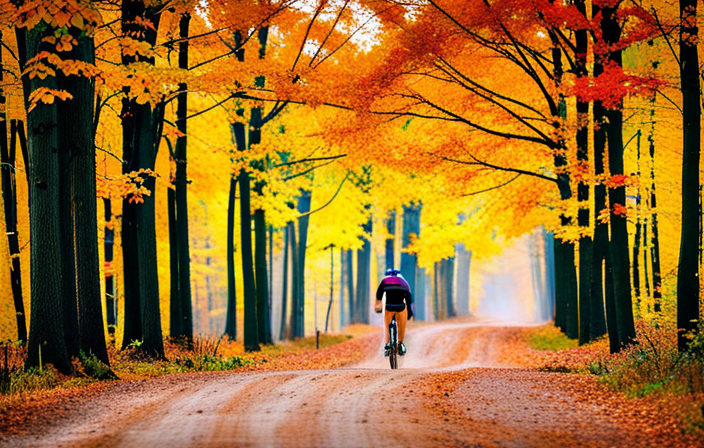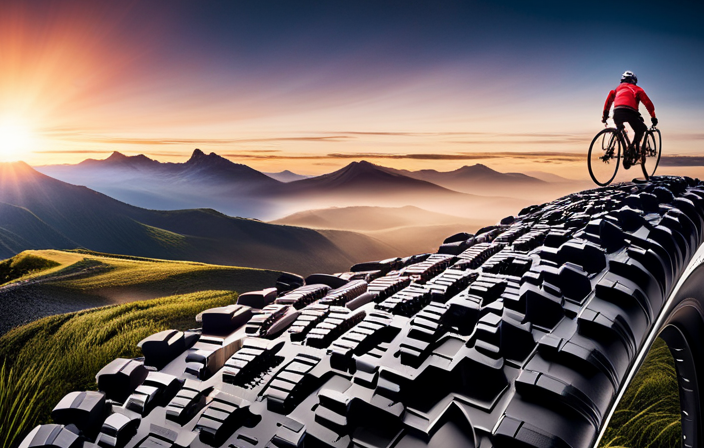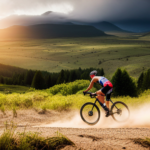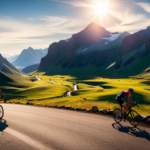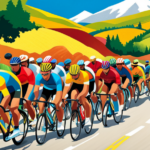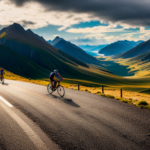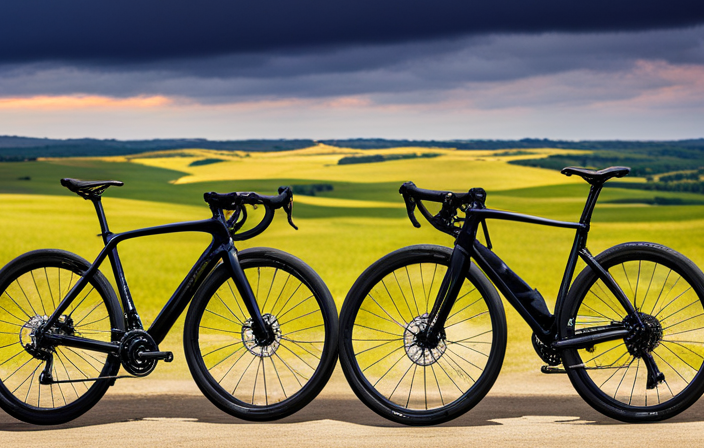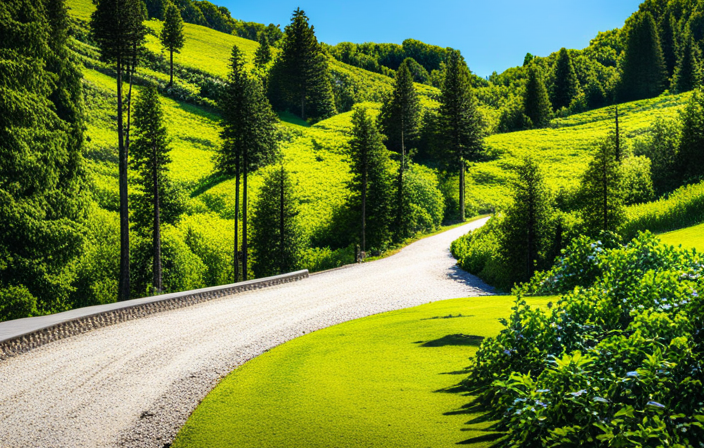Did you realize that gravel bike racing is now one of the fastest-growing cycling disciplines in Minnesota? With its mix of tough terrain, stunning views, and a friendly community, it’s no surprise that an increasing number of cyclists are gravitating towards this exciting sport.
If you’re ready to take your cycling adventures to the next level and start riding gravel bike races in MN, this article is your ultimate guide. From understanding the basics to training effectively and preparing for race day, I’ll provide you with all the essential information you need to get started.
Let’s dive in!
Key Takeaways
- Understand the differences between gravel races and traditional road races
- Choose the right bike and gear for gravel racing in Minnesota
- Focus on building endurance and stamina through training
- Learn how to navigate gravel trails effectively and adjust technique for different surface conditions
Understanding Gravel Bike Racing
If you’re new to gravel bike racing, it’s important to understand the unique aspects of this type of competition. Gravel races differ from traditional road races in many ways, and having a good understanding of race rules and tactics is crucial for success.
One key aspect of gravel bike racing is understanding the race rules. Unlike road races that take place on smooth pavement, gravel races are held on unpaved roads or trails, which can present different challenges and hazards. It’s important to familiarize yourself with the specific rules of each race you plan to participate in, such as how drafting is allowed or prohibited, how passing should be done safely, and any other regulations that may apply.
Another important aspect to consider is analyzing race tactics. Gravel races often require a combination of endurance, strength, and strategy. Analyzing your competitors’ strengths and weaknesses can help you develop an effective race strategy. Knowing when to attack, when to conserve energy, and how to position yourself within the group can make a significant difference in your performance.
Understanding these aspects will greatly enhance your gravel bike racing experience.
In the next section about choosing the right bike and gear, we’ll delve into the equipment needed for this exciting sport without compromising performance.
Choosing the Right Bike and Gear
When choosing the right bike and gear for gravel races in Minnesota, it’s important to consider factors such as terrain and weather conditions. Here are three key considerations:
-
Bike Maintenance:
Gravel racing can be tough on your bike, so regular maintenance is essential. Make sure your bike is in top condition by checking the brakes, tires, and drivetrain regularly. Keep spare tubes, a multi-tool, and a mini-pump handy for quick repairs on the trail. -
Terrain-Specific Bike Features:
The type of terrain you’ll encounter during gravel races in Minnesota will influence your choice of bike features. Look for wider tires with good traction for loose gravel surfaces. Consider a carbon frame or suspension system to absorb vibrations on rougher terrains. -
Essential Gear Items:
In addition to a reliable bike, there are essential gear items that will enhance your performance and keep you safe during races. A well-fitting helmet is a must-have for any cyclist. Invest in padded cycling shorts to improve comfort during long rides. Don’t forget gloves for better grip and protection against blisters.
By carefully considering these factors when choosing your bike and gear, you’ll be well-prepared for the challenges of gravel racing in Minnesota.
Now let’s transition into discussing how to train effectively for these races without skipping a beat!
Training for Gravel Bike Races
When training for gravel bike races, it’s essential to focus on building endurance and stamina. This can be achieved through a combination of long rides, interval training, and cross-training activities such as running or swimming.
Additionally, incorporating off-road riding into your training is crucial to improve bike handling skills and adaptability to different terrains.
Lastly, including strength and conditioning exercises in your training routine will help develop the necessary muscles and prevent injuries during races.
Building endurance and stamina
To build endurance and stamina for gravel bike races, it’s important to incorporate regular long-distance rides into your training routine. These rides are essential for improving cardiovascular fitness, as they challenge your heart and lungs to work harder over extended periods of time. Aim to gradually increase the distance of your long rides each week, pushing yourself a little further each time.
Additionally, fueling properly for these rides is crucial. Make sure to consume a balanced mix of carbohydrates, proteins, and fats before, during, and after your long-distance rides to provide sustained energy and aid in muscle recovery.
By consistently incorporating these long rides into your training regimen and fueling properly, you’ll develop the endurance and stamina necessary for successful gravel bike racing.
Now that you have built a solid foundation of endurance and stamina through regular long-distance rides, it’s time to focus on incorporating off-road riding into your training.
Incorporating off-road riding into your training
Once you have established a strong foundation of endurance and stamina through regular long-distance rides, it’s time to incorporate off-road riding into your training routine.
Off-road riding is essential for gravel bike races as it helps build the necessary skills and adaptability required for varied terrains.
To maximize your performance, consider incorporating strength training exercises into your routine. Focus on exercises that target the muscles used during off-road riding, such as squats, lunges, and core exercises like planks and Russian twists.
Additionally, pay attention to your nutrition when preparing for off-road riding. Make sure to fuel your body with a balanced diet that includes carbohydrates for energy, protein for muscle repair, and plenty of hydration.
By incorporating both strength training and proper nutrition into your training plan, you will be better prepared for the challenges of gravel bike races.
Transitioning now to the subsequent section about ‘strength and conditioning exercises,’ let’s dive deeper into specific workouts that can enhance your performance even further.
Strength and conditioning exercises
Incorporating off-road riding into your training routine can be enhanced by incorporating strength and conditioning exercises. These exercises are crucial for improving overall performance, endurance, and preventing injuries while riding gravel bike races in Minnesota.
One key aspect is developing a strong core through specific core exercises such as planks, Russian twists, and bicycle crunches. A strong core provides stability and power transfer during those long rides on uneven terrain.
Additionally, interval training is essential for building stamina and increasing the ability to handle intense efforts during the race. By alternating between high-intensity bursts of speed and active recovery periods, you can simulate race conditions and improve your cardiovascular fitness.
With these strength-building exercises and interval training incorporated into your routine, you’ll be better equipped to navigate the challenging gravel trails and terrain ahead.
Navigating Gravel Trails and Terrain
When riding gravel bike races in Minnesota, you’ll need to navigate through various types of terrain and trails. It’s essential to have the skills and knowledge to handle the challenges that come with gravel riding.
One key aspect is understanding how to navigate gravel trails effectively. Gravel trails can vary in surface conditions, from loose gravel to packed dirt, and it’s crucial to adjust your technique accordingly. Maintaining proper bike control becomes even more important on unstable surfaces.
To navigate these terrains successfully, it’s vital to keep up with regular gravel bike maintenance. Ensuring that your tires are properly inflated and have adequate tread will provide better traction on uneven surfaces. Additionally, maintaining a clean drivetrain will prevent unnecessary wear and tear on your components.
In terms of nutrition for endurance riding, it’s important to fuel yourself adequately before and during the race. Consuming a balanced meal with carbohydrates, protein, and healthy fats will give you sustained energy throughout the event. During the race, stay hydrated by drinking water or electrolyte beverages regularly.
As you prepare for race day, having a solid understanding of navigating gravel trails and maintaining your bike is essential. With this knowledge in hand, you can confidently move forward into the next section about preparing for race day without missing a beat.
Preparing for Race Day
To prepare for race day, make sure you have a well-thought-out plan and stick to it. Training is essential for success in gravel bike races. You need to build up your endurance and strength by incorporating long rides into your training regimen. Focus on improving your climbing abilities as many gravel courses feature challenging hills. Additionally, include interval training to enhance your speed and power output.
Nutrition plays a crucial role in maximizing performance during the race. Prioritize consuming a balanced diet that consists of carbohydrates, protein, and healthy fats. Hydration is also key, so drink plenty of water throughout the day leading up to the race.
Mental preparation is just as important as physical training. Visualize yourself crossing the finish line with confidence and determination. Develop strategies to stay motivated during tough moments in the race.
As you complete your preparations for race day, remember to review different race strategies and tactics that will give you an edge over your competitors without explicitly stating ‘step.’
Race Strategies and Tactics
Developing effective race strategies and tactics will give you the competitive edge needed to succeed in gravel bike races. Here are four key race tactics and pacing strategies that can help you maximize your performance on race day:
-
Start strong, but pace yourself: It’s important to get a good start and find yourself in a favorable position early on. However, don’t go all out at the beginning. Pace yourself strategically, knowing that gravel races can be long and demanding.
-
Master the art of drafting: Take advantage of drafting opportunities whenever possible. Riding close behind another rider can save energy by reducing wind resistance. But remember to maintain a safe distance and avoid sudden moves that could lead to accidents.
-
Choose your lines wisely: Gravel races often feature rough terrain with varying conditions. Learn how to read the road ahead and choose the best line through corners, loose gravel sections, or technical descents. Smoothly navigating these sections will conserve energy and improve your overall speed.
-
Stay mentally focused: Endurance is just as much about mental strength as it is physical fitness. Stay focused throughout the race, especially during challenging moments when fatigue sets in or unexpected obstacles arise.
By employing these race tactics and pacing strategies, you’ll increase your chances of success in gravel bike races while maintaining safety and etiquette on the course.
Safety and Etiquette in Gravel Racing
To ensure a safe and respectful gravel racing experience, it’s crucial that you prioritize safety and etiquette while navigating the course.
Gravel race etiquette revolves around being considerate to fellow riders and the environment. When passing slower riders, announce your presence with a friendly shout or bell ring, allowing them time to move aside safely. It’s also important to maintain a consistent line and avoid sudden movements that could cause accidents or collisions.
Safety precautions are paramount in gravel racing due to the challenging terrain and potential hazards. Always wear a helmet to protect yourself from head injuries. Additionally, make sure your bike is in good condition by checking the tires for proper inflation, brakes for responsiveness, and gears for smooth shifting. Carry essential tools such as spare tubes, tire levers, and a multi-tool kit in case of mechanical issues.
Furthermore, be mindful of the natural surroundings during gravel races. Avoid littering by disposing of any trash appropriately at aid stations or designated areas. Respect private property rights by staying on marked routes and not trespassing on unauthorized land.
By adhering to gravel race etiquette and following safety precautions, you can have an enjoyable and incident-free experience on the course.
Now let’s explore how to find exciting gravel races in Minnesota without missing out on any opportunities!
Finding Gravel Races in Minnesota
When searching for gravel races in Minnesota, it’s important to explore various online platforms and cycling communities. These resources can provide you with information on upcoming races, registration details, and race routes. Here are three helpful tips to make your search easier:
-
Check online platforms: Websites such as BikeReg, Gravel Cyclist, and Minnesota Cycling Federation often list gravel races happening in Minnesota. These platforms allow you to filter races based on location, date, and distance, making it convenient to find events that suit your preferences.
-
Join social media groups: Facebook groups like ‘Minnesota Gravel Racing’ or ‘Gravel Grinders of the Midwest’ are great places to connect with fellow riders and stay updated on gravel racing events. Members often share race recommendations and post about new race announcements.
-
Attend local cycling events: Participating in local group rides or cycling events can help you network with experienced riders who may have insider information about upcoming gravel races. They can also provide guidance on gravel race preparation and race day nutrition.
By exploring these avenues, you’ll be well-prepared for your first gravel race in Minnesota. Once you’ve found a few races that interest you, the next step is joining a gravel racing community where you can learn from experienced riders and gain valuable insights into the sport.
Joining a Gravel Racing Community
Joining a gravel racing community has numerous benefits. Not only do you have the opportunity to connect with like-minded individuals who share your passion for gravel biking, but you also gain access to a wealth of knowledge and experience.
Finding training partners and group rides becomes easier, providing you with the perfect environment to push your limits and improve your skills. Additionally, connecting with experienced riders and mentors can greatly enhance your understanding of gravel racing techniques and strategies, helping you become a more competitive rider.
Benefits of joining a gravel racing community
Discover the numerous advantages of becoming part of a gravel racing community. Joining a gravel racing community provides valuable networking opportunities, allowing you to connect with fellow riders who share your passion for gravel bike races in Minnesota. Through these connections, you can gain crucial insights and tips from experienced racers, helping you improve your performance on the racecourse.
Additionally, being part of a community means having access to a wealth of knowledge about different race experiences that can guide your training and preparation.
-
Networking opportunities: Connect with like-minded individuals who can provide support and guidance throughout your racing journey.
-
Sharing race experiences: Learn from others’ successes and failures to enhance your own strategies.
-
Expanding horizons: Discover new races and events through recommendations from fellow community members.
By joining a gravel racing community, you’ll not only find training partners and group rides but also establish meaningful connections with fellow racers who share your love for gravel biking in Minnesota.
Finding training partners and group rides
To find training partners and group rides, you can easily connect with fellow gravel racers who share your passion for biking. Joining a gravel racing community opens up a world of opportunities to meet like-minded individuals and improve your skills on the bike.
By participating in group rides, you not only push yourself to ride harder and faster but also learn from others’ experiences. Riding with experienced riders can provide valuable insights into technique, pacing, and race strategies.
Additionally, training with a group allows for accountability and motivation, as you are more likely to stick to your training plan when surrounded by dedicated individuals. Connecting with experienced riders and mentors is crucial in developing your riding abilities and gaining the knowledge needed to excel in gravel bike races without feeling overwhelmed or lost.
Connecting with experienced riders and mentors
Connecting with experienced riders and mentors is crucial in developing your riding abilities and gaining the knowledge needed to excel in gravel bike races without feeling overwhelmed or lost.
To connect with local riders, start by joining cycling clubs or groups in your area. These communities often have regular group rides where you can meet fellow riders and learn from their experiences.
Seeking advice from experienced racers is also a great way to gain valuable insights and tips. Attend local races or events and strike up conversations with those who have been racing for a while. They can provide guidance on training techniques, race strategies, and equipment recommendations.
By connecting with these individuals, you’ll be able to tap into a wealth of knowledge that will help you improve as a rider.
Transitioning into the next section about overcoming challenges and pushing your limits, it’s important to remember that building relationships within the biking community can provide the support and encouragement needed to face any obstacle head-on.
- Join cycling clubs or groups
- Attend local races or events
- Seek advice from experienced racers
Transitioning into the next section about overcoming challenges…
Overcoming Challenges and Pushing Your Limits
When it comes to gravel racing, mental strategies play a crucial role in overcoming fatigue and pain on the bike. Pushing through physical boundaries requires a strong mindset and the ability to persevere when faced with challenges.
Additionally, dealing with race-day setbacks and obstacles is an inevitable part of the sport, but having the mental resilience to adapt and overcome can make all the difference in achieving success.
Lastly, pushing your limits and setting new goals is essential for growth as a gravel racer. By constantly pushing yourself outside of your comfort zone, you can continue to improve your performance and reach new levels of achievement.
Mental strategies for overcoming fatigue and pain
Push through the fatigue and pain by reminding yourself of why you love gravel bike racing. When it comes to overcoming mental barriers during a race, managing race day nerves is crucial.
One strategy is to focus on your training and preparation leading up to the event. Remind yourself of all the hard work you put in and how far you’ve come. Another helpful technique is to break the race down into smaller sections or goals, such as reaching a certain checkpoint or maintaining a specific pace for a set distance. This can help distract your mind from the fatigue and pain, allowing you to stay focused and motivated.
Additionally, positive self-talk can be powerful in boosting your confidence and reducing negative thoughts. Remember that every obstacle you overcome on race day makes you stronger for future challenges ahead.
Now, let’s discuss how to deal with race-day setbacks and obstacles…
Dealing with race-day setbacks and obstacles
To overcome race-day setbacks and obstacles, it’s important to have strategies in place for handling unexpected challenges that may arise during a gravel bike race. One key strategy is to maintain mental resilience and keep a positive mindset. When faced with setbacks such as mechanical issues or getting dropped from a group, it’s crucial to stay calm and problem-solve quickly.
Visualize success and remind yourself of your training and preparation leading up to the race. Another effective technique is to break the race into smaller, manageable segments, setting mini-goals along the way. This helps maintain motivation and prevents feeling overwhelmed by the distance or terrain ahead.
By employing these strategies for overcoming race-day setbacks, you can improve your performance and achieve your goals in gravel bike races.
Now, let’s transition into pushing your limits and setting new goals without writing ‘step’.
Pushing your limits and setting new goals
After dealing with race-day setbacks and obstacles, it’s important to regroup and refocus on pushing your limits and setting new goals.
Mental strategies play a crucial role in overcoming challenges during gravel bike races in Minnesota. One effective strategy is to break the race down into smaller segments, focusing on one section at a time rather than becoming overwhelmed by the entire course. Additionally, visualizing success and positive outcomes can help boost confidence and motivation. It’s also helpful to set realistic yet challenging goals for each race, whether it’s improving your finishing time or conquering difficult terrain.
By constantly pushing your limits and striving for improvement, you can continue to grow as a rider and achieve new milestones.
Now, let’s explore the importance of post-race recovery and reflection in order to optimize your performance for future races.
Post-Race Recovery and Reflection
After completing a challenging gravel bike race in Minnesota, it’s crucial to prioritize proper recovery techniques and rest days.
This will allow my body to heal and rebuild, ensuring that I can continue pushing my limits in future races.
Additionally, taking the time to reflect on my race performance and identify areas for improvement will help me become a stronger rider.
Lastly, celebrating my achievements from the race and setting new goals will keep me motivated and excited for future challenges.
Proper recovery techniques and rest days
Rest days and proper recovery techniques are essential for gravel bike racers to prevent burnout and optimize performance. After a grueling race, it is crucial to allow the body time to rest and recover.
One effective technique is active recovery, which involves engaging in low-intensity activities like light cycling or stretching. This helps increase blood flow and flush out metabolic waste products from the muscles, promoting faster healing and reducing muscle soreness.
Additionally, incorporating rest days into your training schedule allows your body to repair damaged tissues and replenish energy stores. It is important to listen to your body’s signals and not push yourself too hard during these rest days.
By prioritizing adequate recovery, you can decrease the risk of injury and improve overall performance in future races.
Reflecting on race performance and identifying areas for improvement is the next step in becoming a better gravel bike racer.
Reflecting on race performance and areas for improvement
To become a better gravel bike racer, you can reflect on your race performance and identify areas for improvement. Race performance analysis is a crucial step in understanding your strengths and weaknesses as a rider. By analyzing factors such as average speed, power output, and race tactics, you can pinpoint specific areas that need improvement.
Here are three sub-lists to consider during your analysis:
-
Technique: Assess your cornering skills, descending abilities, and overall bike handling. Identify any areas where you can improve your efficiency and control.
-
Training plan adjustments: Evaluate the effectiveness of your current training regimen. Are you incorporating enough interval workouts? Should you focus more on endurance rides or strength training?
-
Mental preparation: Reflect on how well you maintained focus during the race and managed stress levels. Consider implementing techniques such as visualization or meditation to enhance mental resilience.
By performing a thorough race performance analysis and making necessary adjustments to your training plan, you can continue to progress as a gravel bike racer. Transitioning into celebrating achievements and setting new goals allows for continued growth in this exciting sport without missing a beat!
Celebrating your achievements and setting new goals
As you celebrate your achievements in gravel bike racing, it’s important to set new goals to continue pushing yourself and growing in the sport.
Setting new goals allows you to maintain focus and motivation as you strive for further success. Start by reflecting on your recent accomplishments and identifying areas where you can improve.
Perhaps you want to increase your average speed, conquer more challenging terrain, or participate in longer races. By setting specific, measurable goals, such as completing a certain number of races within a season or achieving a personal best time, you can track your progress and hold yourself accountable.
Celebrating milestones along the way will keep you motivated and excited about your journey in gravel bike racing.
Now that we’ve discussed celebrating achievements and setting new goals, let’s explore how to incorporate gravel racing into your cycling lifestyle without compromising other aspects of training.
Incorporating Gravel Racing into Your Cycling Lifestyle
When incorporating gravel racing into your cycling lifestyle, it’s important to find a balance between training and recovery. Gravel racing can be physically demanding, so proper preparation is crucial. One of the benefits of joining a gravel racing community is the opportunity to connect with experienced riders who can offer guidance on training plans and techniques.
To help you visualize the importance of balancing training and recovery, take a look at the table below:
| Training | Recovery |
|---|---|
| Interval workouts | Rest days |
| Long endurance rides | Foam rolling |
| Strength training | Sleep |
By incorporating these elements into your routine, you’ll optimize your performance while minimizing the risk of injury or burnout. Additionally, being part of a gravel racing community provides a supportive environment where you can share experiences and learn from fellow riders.
Now that we’ve discussed incorporating gravel racing into your cycling lifestyle, let’s delve into inspiring gravel racing stories and profiles.
Inspiring Gravel Racing Stories and Profiles
When it comes to gravel racing, there is so much inspiration to be found in the stories and profiles of experienced racers. Their interviews provide valuable insights into the world of gravel racing, offering tips and strategies for success.
These riders’ personal growth and transformation through their journey in gravel racing also serve as powerful motivators for anyone looking to embark on their own adventure.
Additionally, exploring the profiles of notable gravel race events and champions gives a glimpse into the excitement and achievements that can be attained in this unique discipline of cycling.
Interviews with experienced gravel racers
To get valuable insights, it’s worth interviewing experienced gravel racers. I had the opportunity to speak with three seasoned racers about their experiences and tips for beginners. Here is what they shared:
| Racer | Experiences of Racing Gravel Bikes | Tips for Beginner Gravel Racers |
|---|---|---|
| Sarah | Conquering challenging terrains and pushing personal limits are the highlights of my gravel racing journey. The feeling of accomplishment after completing a tough race is unbeatable. | Start slow and gradually increase your mileage and intensity. Invest in a good bike that suits your riding style. Don’t forget to train on different surfaces to prepare yourself for diverse conditions during races. |
| John | Gravel racing has taught me resilience and mental toughness. Pushing through fatigue and embracing discomfort is crucial for success in this sport. | Find a supportive community of fellow riders who can provide guidance and motivation along the way. Experiment with nutrition strategies during long rides to find what works best for you. |
| Emily | For me, gravel racing is all about exploring new places and connecting with nature while testing my physical abilities. The sense of freedom is unparalleled. | Embrace challenges as opportunities for growth rather than obstacles to overcome. Enjoy the process and don’t be afraid to push yourself beyond your comfort zone. |
These interviews shed light on the transformative power of gravel racing, which will be further explored in the subsequent section about stories of personal growth and transformation through gravel racing.
Stories of personal growth and transformation through gravel racing
Gravel racing has the incredible ability to inspire personal growth and transformation in individuals. It is more than just a race; it’s an opportunity to push your limits, overcome challenges, and discover new strengths within yourself. Through gravel racing, I have experienced personal growth in ways I never thought possible.
Here are four reasons why gravel racing can lead to transformative experiences:
-
Mental resilience: The demanding nature of gravel races teaches you how to stay focused, maintain a positive mindset, and push through mental barriers.
-
Physical endurance: Training for and participating in gravel races pushes your body to its limits, helping you build strength, stamina, and overall fitness.
-
Self-discovery: Gravel racing allows you to explore your own capabilities and uncover hidden potential that you may not have realized before.
-
Community support: The gravel racing community is incredibly supportive, fostering a sense of belonging and encouraging personal growth through shared experiences.
These transformative experiences lay the foundation for profiles of notable gravel race events and champions.
Profiles of notable gravel race events and champions
After hearing stories of personal growth and transformation through gravel racing, I was inspired to explore the world of notable gravel race events and champions.
Gravel racing is not limited to Minnesota; there are incredible gravel race events in other states that attract riders from all over the country. These events offer a variety of challenging terrains and distances, allowing riders to test their skills and endurance.
Additionally, there are notable gravel race champions from around the world who have achieved remarkable feats in this discipline. Their achievements serve as motivation for aspiring gravel racers like myself, showing what is possible with determination and training.
As I continue my journey into the world of gravel racing, I look forward to supporting the gravel racing community and fostering its growth.
Supporting the Gravel Racing Community
When it comes to supporting the gravel racing community, there are several key points to consider.
First, volunteering at gravel races is a great way to contribute and show your support for the sport.
Secondly, supporting local gravel race organizers and businesses helps to ensure the sustainability of these events.
And finally, promoting inclusivity and diversity in gravel racing is crucial for creating a welcoming and equitable environment for all participants.
By actively engaging in these three areas, we can make a positive impact on the gravel racing community.
Volunteering at gravel races
Volunteering at gravel races is a great way to get involved in the community. Not only does it provide opportunities for people to support local events, but it also offers numerous benefits for volunteers themselves. By lending a helping hand, you can play a vital role in making these races successful and enjoyable for participants. To give you an idea of the various volunteering opportunities available, here’s a breakdown:
| Race Day Roles | Pre-Race Roles | Post-Race Roles |
|---|---|---|
| Course Marshal | Registration Assistant | Clean-up Crew |
| Aid Station Attendant | Route Marker Installer | Equipment Organizer |
| Parking Coordinator | Packet Pick-Up Volunteer | Results Tabulator |
Being part of the volunteer team allows you to learn more about race organization, meet fellow enthusiasts, and contribute to the overall experience. Once you’ve experienced the satisfaction of supporting gravel races firsthand, you’ll be motivated to explore other ways of supporting local gravel race organizers and businesses.
Supporting local gravel race organizers and businesses
After volunteering at gravel races, I realized the importance of supporting local gravel race organizers and businesses. By promoting these local entities, we can ensure the growth and sustainability of the gravel racing community.
One way to support them is by actively participating in their events, whether it be as a racer or a spectator. Additionally, spreading the word about these races through social media and word-of-mouth can help attract more participants and generate buzz around the event. Lastly, purchasing merchandise or services from local businesses that are involved with gravel racing is another great way to show support.
To create a welcoming race environment, it is crucial that we promote inclusivity and diversity in gravel racing. This means encouraging racers of all backgrounds and abilities to participate and providing resources for them to feel supported throughout their journey.
Promoting inclusivity and diversity in gravel racing
Promoting inclusivity and diversity in gravel racing is essential for creating a welcoming race environment. In recent years, there has been a growing recognition of the need to promote diversity and equality in all aspects of life, including sports. Gravel racing is no exception. To ensure that everyone feels welcome and encouraged to participate, many race organizers have implemented inclusion initiatives in gravel racing.
These initiatives focus on providing equal opportunities for individuals of all backgrounds and abilities to take part in races. They also aim to create an atmosphere where participants feel valued and respected, regardless of their gender, ethnicity, or socioeconomic status. By promoting diversity and equality in gravel racing, we can foster a stronger community and ultimately improve the sport for everyone involved.
In conclusion, it is clear that promoting inclusivity and diversity is crucial for the future success of gravel racing. However, this work does not end here – we must continue to actively support these initiatives as participants, organizers, and supporters of the sport. Together, we can create an even more inclusive environment where every individual feels empowered to pursue their passion for gravel racing without barriers or discrimination.
Transitioning into the next section: As we look towards the future of gravel racing…
Conclusion and Next Steps
In conclusion, we have discussed some key takeaways and tips for starting your gravel racing journey.
It is important to remember the importance of training, proper equipment, and nutrition for success in this sport.
I encourage you to start your gravel racing journey with confidence and determination, as it can be a rewarding and challenging experience.
If you are looking for further learning and exploration, there are plenty of resources available online such as forums, blogs, and websites dedicated to gravel racing that can provide valuable information and insights into this growing community.
Recap of key takeaways and tips
To recap, here are some key takeaways and tips to keep in mind as you start riding gravel bike races in MN.
-
Mental strategies are crucial for race day setbacks. Stay focused and positive, even when faced with challenges or setbacks during the race.
-
Maintain a steady pace and conserve energy for the long haul.
-
Familiarize yourself with the course beforehand to strategize accordingly.
-
Pay attention to nutrition and hydration, as fueling your body properly is essential for endurance events like gravel races.
-
Lastly, don’t forget to enjoy the journey! Gravel racing is as much about the experience as it is about the competition.
With these tips in mind, you’re ready for your gravel racing journey ahead.
Now let’s move on to some encouragement to start your gravel racing journey.
Encouragement to start your gravel racing journey
Feeling inspired? Ready to embark on your gravel racing adventure? Finding motivation to start something new can be challenging, but the thrill of pushing your limits and conquering new terrains is worth it.
Overcoming fear is a natural part of the process, but don’t let it hold you back. Remember that everyone starts somewhere, and with time and practice, you’ll gain confidence and improve your skills.
Surround yourself with supportive individuals who share your passion for gravel racing. Connect with local cycling communities or join online forums to find like-minded individuals who can offer guidance and encouragement along the way.
By taking that initial leap of faith, you’ll soon find yourself immersed in a world of exhilarating races and unforgettable experiences.
Now, let’s explore some resources for further learning and exploration.
Resources for further learning and exploration
Looking for more information on gravel racing? Here are some resources to help you further your knowledge and explore the world of gravel bike races:
-
Websites: Check out popular websites like Gravel Cyclist and Riding Gravel for in-depth articles, race reviews, and training tips.
-
Books: Consider reading ‘Gravel Cycling’ by Nick Legan or ‘The Complete Guide to Gravel Racing and Adventure Bikepacking’ by Phil Gaimon for comprehensive guides on all things gravel racing.
-
Podcasts: Tune into podcasts such as The Gravel Ride Podcast and The Dirty Chain Podcast to listen to interviews with experienced racers, nutrition experts, and discussions about injury prevention.
-
Local Clubs: Joining a local cycling club can provide you with valuable advice from seasoned riders who have experience in gravel racing.
When it comes to gravel racing, it’s crucial to prioritize injury prevention, nutrition, and hydration. Make sure to incorporate proper stretching routines before rides, wear protective gear like helmets, and maintain a balanced diet that supports your energy needs.
Stay hydrated throughout your races by drinking water or electrolyte-rich beverages regularly. Remember that staying informed is key to success in this challenging sport!
Frequently Asked Questions
What are the benefits of joining a gravel racing community?
Joining a gravel racing community offers numerous benefits. First and foremost, you gain access to a strong network of like-minded individuals who provide invaluable community support. Whether it’s sharing race strategies or offering encouragement, this sense of camaraderie is essential for success in the sport.
Additionally, these communities often provide excellent training resources that can help improve your skills and enhance your performance on the gravel race circuit. Being part of such a community opens up opportunities for growth and development in your racing journey.
How do I find gravel races in Minnesota?
To find gravel races in Minnesota, I recommend using online resources like cycling event websites or social media groups dedicated to gravel racing. These platforms often have event listings and discussions about local races.
Additionally, reaching out to local bike shops or cycling clubs can provide valuable information on upcoming events.
As for training tips, focus on building endurance, improving off-road handling skills, and incorporating interval training to prepare for the challenging terrain of gravel races.
What are some common challenges faced during gravel bike races?
During gravel bike races, I face several common challenges.
One of them is equipment maintenance. Gravel roads can be rough on bikes, so it’s important to regularly clean and inspect your bike for any issues.
Another challenge is nutrition strategies. It’s crucial to fuel your body with the right foods and stay hydrated during long races. Proper nutrition can help maintain energy levels and prevent fatigue.
How can I incorporate gravel racing into my cycling lifestyle?
To fully embrace the thrill of gravel racing, I’ve integrated it seamlessly into my cycling lifestyle.
Exploring the untamed paths, I discover hidden gems and push my limits with each pedal stroke.
Finding gravel routes has become a thrilling quest, as I seek out challenging terrains that test my skills and endurance.
To prepare for these races, I diligently follow a training regimen that focuses on building strength and improving off-road handling.
With dedication and determination, gravel racing has become an exhilarating part of my cycling journey.
Can you share any inspiring gravel racing stories or profiles?
Sure!
When it comes to inspiring gravel race stories, there are countless tales of triumph and perseverance. From riders pushing through extreme weather conditions to battling challenging terrains, these stories showcase the true grit and determination of gravel racers.
Additionally, gravel race profiles provide valuable insights into the courses, distances, and elevation gains of various races. They can help aspiring racers gauge their abilities and choose events that align with their goals.
Conclusion
In conclusion, gravel bike racing is not just a sport, but a thrilling adventure that pushes your limits and fuels your passion for cycling.
With the right bike, gear, and training, you can conquer any gravel trail and compete in exhilarating races.
So lace up your shoes, hop on your bike, and embrace the unpredictable nature of gravel racing.
Remember, in the world of gravel racing, every obstacle is an opportunity to shine like a shooting star in the night sky.
So go out there and chase your dreams on those dusty roads!
